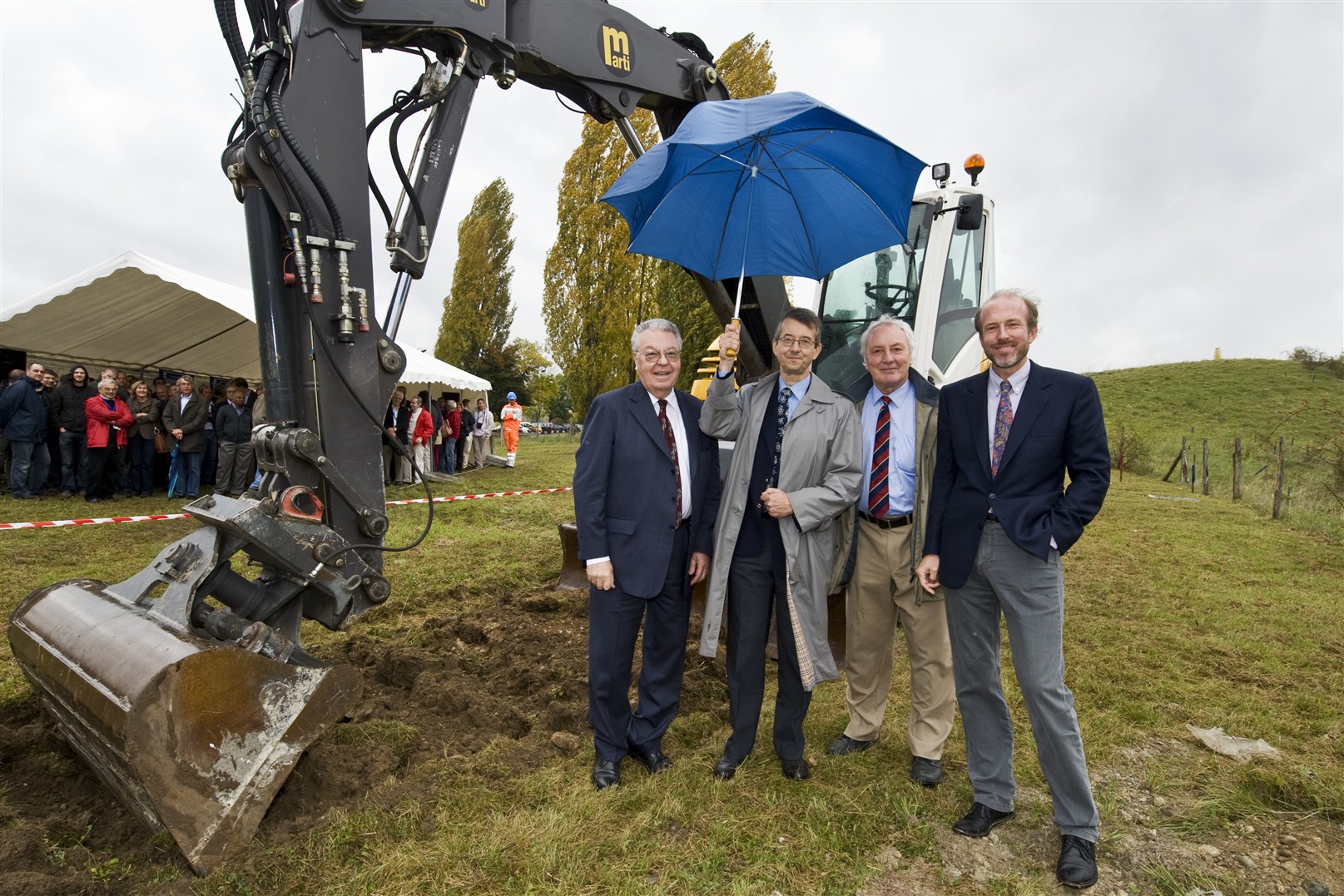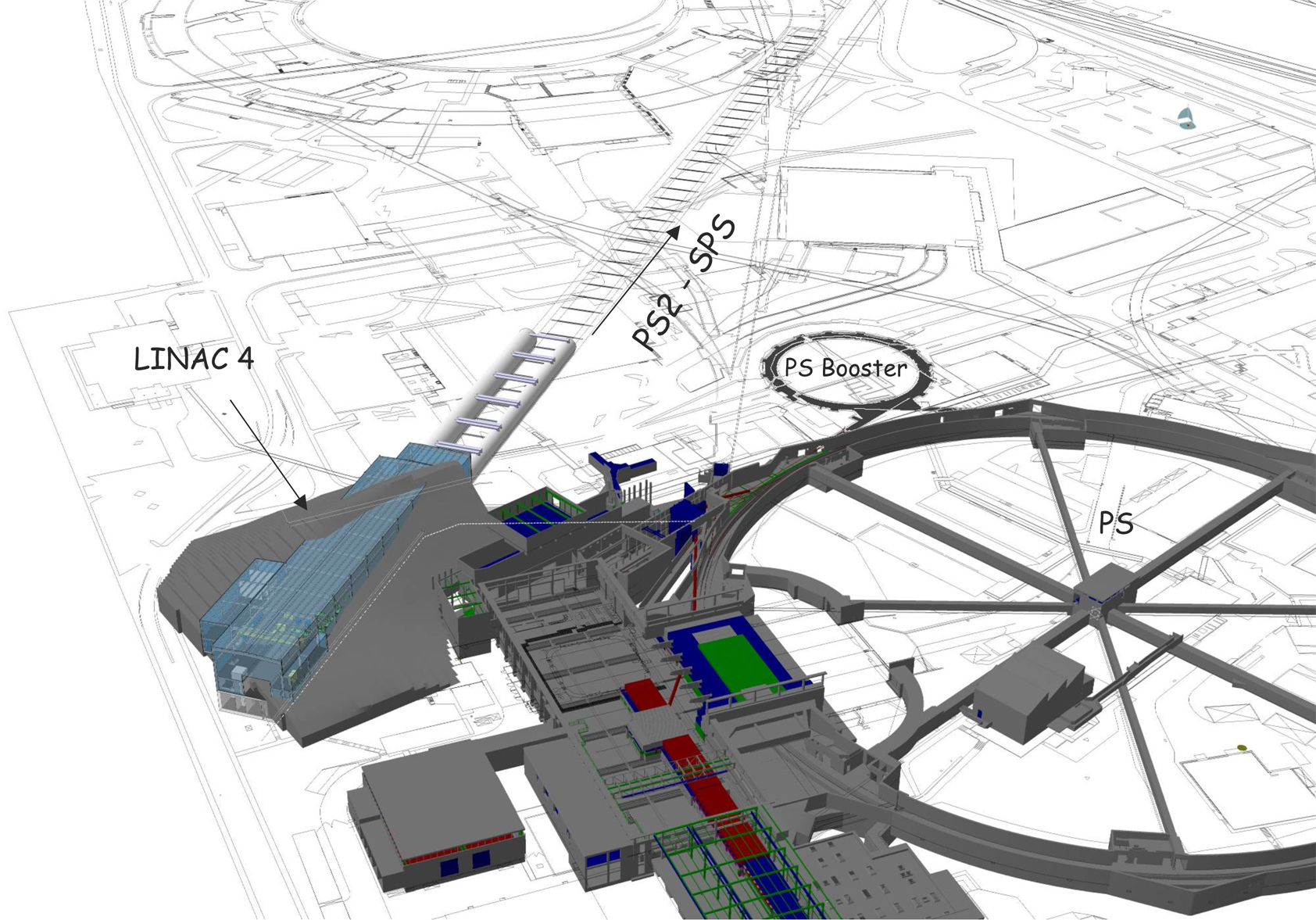The new Linac moves mountains
The civil engineering work has started for Linac 4, one of the major renovation projects for the CERN accelerator complex. The work will be completed at the end of 2010 and the new linear accelerator is scheduled to be commissioned in 2013.
Ground-breaking ceremony for Linac 4. From left to right: Rober Aymar, CERN Director-General, Roland Garoby, SPL Project Leader, Lyn Evans, LHC and LHC Upgrade Project Leader, and Maurizio Vretenar, Linac 4 Project Leader.
Named after a former CERN physicist and one of the few remaining areas available for development on the Meyrin site, the Mont-Citron is about to be razed to make way for the construction of the new CERN linear accelerator, the Linac 4, which from 2013 will be the first link in the proton injector chain. On Thursday, 16 October, the ground-breaking ceremony took place on a site between the PS buildings and Restaurant No. 2.
Linac 4 is the first project to be built in the framework of the programme of new initiatives approved by the CERN Council in June 2007 with additional resources amounting to 240 MCHF for the period 2008 to 2011. The programme includes consolidation and upgrade of the LHC and its injectors, including the construction of Linac 4 and design studies for other injectors to be constructed in a second phase.
The replacement of Linac 2, which has just celebrated 30 years of service, is an essential component of the future LHC upgrade. Once the nominal luminosity has been reached, further physics research will depend on a gradual increase in the LHC’s luminosity. Energy and luminosity are the two critical parameters of an accelerator: where luminosity determines the frequency of particle collisions. The current LHC injector chain is the main impediment to an increase in luminosity. The injection complex should deliver much denser beams, but this is impossible with the existing machines. In addition, although of excellent and proven reliability, CERN’s injection complex is beginning to show signs of ageing. The Proton Synchrotron (PS) will be celebrating its 50th anniversary next year!
The Linac is the first link in the proton acceleration chain. It is in this long straight section that the protons, extracted from a simple bottle of hydrogen, are first accelerated and focused. They are then accelerated in the PS Booster, in the Proton Synchrotron (PS) and in the Super Proton Synchrotron (SPS) before reaching the LHC ring.
From 2013, Linac 4 will supply beams at an energy of 160 MeV, compared to the 50 MeV beams of the current Linac 2. This 80 m long accelerator (in contrast to the 36 m of Linac 2) will make it possible for the PS Booster to deliver a beam intensity twice as high, which will contribute to increasing the LHC’s luminosity. "What’s more, it has been designed to take account of future upgrades of the accelerator complex", underlines Maurizio Vretenar, the Linac 4 Project Leader. "In particular it is designed for injection into the PS Booster’s successor." In a second phase, the PS Booster will be replaced by the SPL (Superconducting Proton Linac). The third link in the injection chain, the PS, will in turn be replaced by PS2.
The civil-engineering work for Linac 4 started on 22 October and will last until 2010. It will start with the razing of the Mont-Citron. In fact Mont-Citron is not a natural hill at all. It was artificially created with the spoil from the PS worksite lower down the hill. Once the mound has been razed, a further 12 m will be excavated so that Linac 4 can be buried 2.5 m lower than the PS Booster and also to optimise shielding. About 40 000 cubic metres of earth will therefore have to be removed to an area near Building SM18. So from the end of October there will be a lot of coming and going of lorries (see the article on the modified traffic arrangements, p. 14).
Once the trench has been excavated and the Linac gallery concreting work has been completed, it will be covered over with almost 14 000 cubic metres of the removed spoil. The next phase of the work will entail construction of a 100 m long and 10 m high building. The building has been cleverly sited so as not to encroach on the Franco-Swiss border! Although not apparent to anyone working on the CERN site, the border runs through this area and no building must straddle this invisible line. The building will be constructed on the Swiss side and, in compliance with Swiss legislation, with its foundations starting over 2 m back from the border itself. Once the civil-engineering phase is completed, the machine will be installed in 2011 and 2012.
The Linac 4 project is being undertaken as part of an international collaboration. The R&D work is being carried out as part of a European project, notably involving institutes in France, Italy, Russia, India, Pakistan and Saudi Arabia. "Most of the machine components will also be built in the framework of international collaboration", explains Maurizio Vretenar. But in the grand tradition of CERN, some components won’t need to be specially built. For instance, the radio-frequency power will be provided by reconditioned LEP klystrons.
Did you know?
Particles with the same electric charge repel each other. At low energy, this repulsion, known as Coulomb repulsion, limits the number of particles that can be concentrated in a given volume and thus the beam intensity. But these so-called ‘space charge’ effects diminish as the energy increases and tend towards zero as the particles approach the speed of light. The final energy of the new Linac will be three times higher than that of the current Linac 2. Consequently, the effects of space charge at the moment of injection into the PS Booster will be weaker by a factor of 2. The beam generated will therefore be much more intense. But the physicists have a trick up their sleeves. The Linac 4 will inject hydrogen ions, which each consist of a proton surrounded by two electrons, into the PS Booster rings. This technique, known as charge-exchange injection, was invented in the 1970s and is used in many accelerators around the world. Much denser beams can thereby be obtained, with fewer losses and more flexibility on injection.
How does Linac 4 work?
As its name suggests, a linear accelerator accelerates beams along a straight line. But what its name doesn’t reveal is that it also concentrates them. This latter function is crucial since the lower the energy, which is the case at start-up, the more the particles in the beam tend to repel each other and diverge. The Linac 4 uses four types of accelerating structure with different focusing devices, each adapted to the beam energy. As in the Linac 2, the particles are initially accelerated and focused by a radio-frequency quadrupole, and then by a drift tube linac (DTL). The DTL will comprise 120 specially designed permanent magnets that are smaller and more reliable than the electromagnets in service in Linac 2. These two initial structures will be followed by another type of Linac, known as a cell-coupled drift tube linac (CCDTL), where quadrupoles are interleaved with accelerating cells. Accelerating cavities called pi-mode structures (PIMS), similar to the copper cavities used in LEP, will provide the final boost of acceleration. Linac 4’s hardware will also include an item of equipment called a chopper line. Its role is to cut up the beam at the same frequency as that of the PS Booster, i.e. 600 kHz. Synchronising the frequencies of the two accelerators substantially reduces the particle losses at the injection point into the PS Booster.



